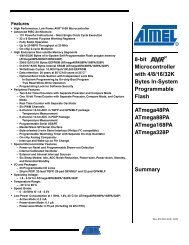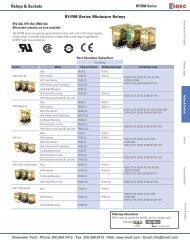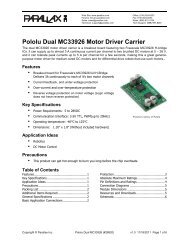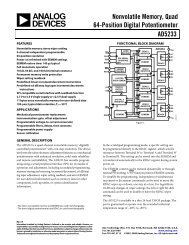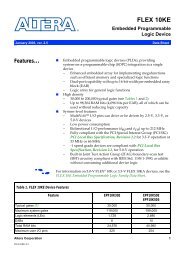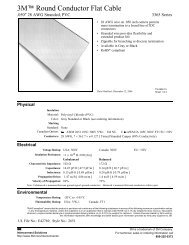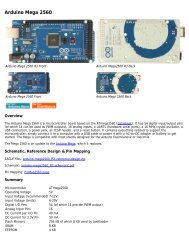- Page 1 and 2: PIC18F2480/2580/4480/4580 Data Shee
- Page 3 and 4: PIC18F2480/2580/4480/4580 28/40/44-
- Page 5 and 6: © 2004 Microchip Technology Inc. P
- Page 7 and 8: PIC18F2480/2580/4480/4580 TO OUR VA
- Page 9 and 10: PIC18F2480/2580/4480/4580 1.0 DEVIC
- Page 11 and 12: PIC18F2480/2580/4480/4580 TABLE 1-1
- Page 13 and 14: PIC18F2480/2580/4480/4580 FIGURE 1-
- Page 15 and 16: PIC18F2480/2580/4480/4580 TABLE 1-2
- Page 17 and 18: PIC18F2480/2580/4480/4580 TABLE 1-2
- Page 19 and 20: PIC18F2480/2580/4480/4580 TABLE 1-3
- Page 21 and 22: PIC18F2480/2580/4480/4580 TABLE 1-3
- Page 23 and 24: PIC18F2480/2580/4480/4580 TABLE 1-3
- Page 25 and 26: PIC18F2480/2580/4480/4580 2.0 OSCIL
- Page 27 and 28: PIC18F2480/2580/4480/4580 2.4 RC Os
- Page 29 and 30: PIC18F2480/2580/4480/4580 REGISTER
- Page 31 and 32: PIC18F2480/2580/4480/4580 2.7.1 OSC
- Page 33 and 34: PIC18F2480/2580/4480/4580 2.8 Effec
- Page 35: PIC18F2480/2580/4480/4580 3.0 POWER
- Page 39 and 40: PIC18F2480/2580/4480/4580 3.3 Sleep
- Page 41 and 42: PIC18F2480/2580/4480/4580 3.4.3 RC_
- Page 43 and 44: PIC18F2480/2580/4480/4580 4.0 RESET
- Page 45 and 46: PIC18F2480/2580/4480/4580 4.2 Maste
- Page 47 and 48: PIC18F2480/2580/4480/4580 4.5 Devic
- Page 49 and 50: PIC18F2480/2580/4480/4580 FIGURE 4-
- Page 51 and 52: PIC18F2480/2580/4480/4580 TABLE 4-4
- Page 53 and 54: PIC18F2480/2580/4480/4580 TABLE 4-4
- Page 55 and 56: PIC18F2480/2580/4480/4580 TABLE 4-4
- Page 57 and 58: PIC18F2480/2580/4480/4580 TABLE 4-4
- Page 59 and 60: PIC18F2480/2580/4480/4580 TABLE 4-4
- Page 61 and 62: PIC18F2480/2580/4480/4580 TABLE 4-4
- Page 63 and 64: PIC18F2480/2580/4480/4580 5.0 MEMOR
- Page 65 and 66: PIC18F2480/2580/4480/4580 5.1.2.2 R
- Page 67 and 68: PIC18F2480/2580/4480/4580 5.2 PIC18
- Page 69 and 70: PIC18F2480/2580/4480/4580 5.3 Data
- Page 71 and 72: PIC18F2480/2580/4480/4580 FIGURE 5-
- Page 73 and 74: PIC18F2480/2580/4480/4580 5.3.4 SPE
- Page 75 and 76: PIC18F2480/2580/4480/4580 TABLE 5-1
- Page 77 and 78: PIC18F2480/2580/4480/4580 TABLE 5-1
- Page 79 and 80: PIC18F2480/2580/4480/4580 TABLE 5-2
- Page 81 and 82: PIC18F2480/2580/4480/4580 TABLE 5-2
- Page 83 and 84: PIC18F2480/2580/4480/4580 TABLE 5-2
- Page 85 and 86: PIC18F2480/2580/4480/4580 TABLE 5-2
- Page 87 and 88:
PIC18F2480/2580/4480/4580 TABLE 5-2
- Page 89 and 90:
PIC18F2480/2580/4480/4580 TABLE 5-2
- Page 91 and 92:
PIC18F2480/2580/4480/4580 5.4 Data
- Page 93 and 94:
PIC18F2480/2580/4480/4580 5.4.3.2 F
- Page 95 and 96:
PIC18F2480/2580/4480/4580 FIGURE 5-
- Page 97 and 98:
PIC18F2480/2580/4480/4580 6.0 FLASH
- Page 99 and 100:
PIC18F2480/2580/4480/4580 REGISTER
- Page 101 and 102:
PIC18F2480/2580/4480/4580 6.3 Readi
- Page 103 and 104:
PIC18F2480/2580/4480/4580 6.5 Writi
- Page 105 and 106:
PIC18F2480/2580/4480/4580 EXAMPLE 6
- Page 107 and 108:
PIC18F2480/2580/4480/4580 7.0 DATA
- Page 109 and 110:
PIC18F2480/2580/4480/4580 7.3 Readi
- Page 111 and 112:
PIC18F2480/2580/4480/4580 TABLE 7-1
- Page 113 and 114:
PIC18F2480/2580/4480/4580 8.0 8 x 8
- Page 115 and 116:
PIC18F2480/2580/4480/4580 9.0 INTER
- Page 117 and 118:
PIC18F2480/2580/4480/4580 9.1 INTCO
- Page 119 and 120:
PIC18F2480/2580/4480/4580 REGISTER
- Page 121 and 122:
PIC18F2480/2580/4480/4580 REGISTER
- Page 123 and 124:
PIC18F2480/2580/4480/4580 9.3 PIE R
- Page 125 and 126:
PIC18F2480/2580/4480/4580 REGISTER
- Page 127 and 128:
PIC18F2480/2580/4480/4580 REGISTER
- Page 129 and 130:
PIC18F2480/2580/4480/4580 9.5 RCON
- Page 131 and 132:
PIC18F2480/2580/4480/4580 10.0 I/O
- Page 133 and 134:
PIC18F2480/2580/4480/4580 TABLE 10-
- Page 135 and 136:
PIC18F2480/2580/4480/4580 TABLE 10-
- Page 137 and 138:
PIC18F2480/2580/4480/4580 10.3 PORT
- Page 139 and 140:
PIC18F2480/2580/4480/4580 TABLE 10-
- Page 141 and 142:
PIC18F2480/2580/4480/4580 TABLE 10-
- Page 143 and 144:
PIC18F2480/2580/4480/4580 10.5 PORT
- Page 145 and 146:
PIC18F2480/2580/4480/4580 TABLE 10-
- Page 147 and 148:
PIC18F2480/2580/4480/4580 FIGURE 10
- Page 149 and 150:
PIC18F2480/2580/4480/4580 11.0 TIME
- Page 151 and 152:
PIC18F2480/2580/4480/4580 11.3 Pres
- Page 153 and 154:
PIC18F2480/2580/4480/4580 12.0 TIME
- Page 155 and 156:
PIC18F2480/2580/4480/4580 12.2 Time
- Page 157 and 158:
PIC18F2480/2580/4480/4580 EXAMPLE 1
- Page 159 and 160:
PIC18F2480/2580/4480/4580 13.0 TIME
- Page 161 and 162:
PIC18F2480/2580/4480/4580 14.0 TIME
- Page 163 and 164:
PIC18F2480/2580/4480/4580 14.2 Time
- Page 165 and 166:
PIC18F2480/2580/4480/4580 15.0 CAPT
- Page 167 and 168:
PIC18F2480/2580/4480/4580 15.2 Capt
- Page 169 and 170:
PIC18F2480/2580/4480/4580 15.3 Comp
- Page 171 and 172:
PIC18F2480/2580/4480/4580 15.4 PWM
- Page 173 and 174:
PIC18F2480/2580/4480/4580 TABLE 15-
- Page 175 and 176:
PIC18F2480/2580/4480/4580 16.0 ENHA
- Page 177 and 178:
PIC18F2480/2580/4480/4580 16.4 Enha
- Page 179 and 180:
PIC18F2480/2580/4480/4580 FIGURE 16
- Page 181 and 182:
PIC18F2480/2580/4480/4580 16.4.5 FU
- Page 183 and 184:
PIC18F2480/2580/4480/4580 FIGURE 16
- Page 185 and 186:
PIC18F2480/2580/4480/4580 REGISTER
- Page 187 and 188:
PIC18F2480/2580/4480/4580 16.4.9 SE
- Page 189 and 190:
PIC18F2480/2580/4480/4580 17.0 MAST
- Page 191 and 192:
PIC18F2480/2580/4480/4580 REGISTER
- Page 193 and 194:
PIC18F2480/2580/4480/4580 17.3.3 EN
- Page 195 and 196:
PIC18F2480/2580/4480/4580 17.3.6 SL
- Page 197 and 198:
PIC18F2480/2580/4480/4580 17.3.8 OP
- Page 199 and 200:
PIC18F2480/2580/4480/4580 REGISTER
- Page 201 and 202:
PIC18F2480/2580/4480/4580 REGISTER
- Page 203 and 204:
PIC18F2480/2580/4480/4580 17.4.3.2
- Page 205 and 206:
PIC18F2480/2580/4480/4580 FIGURE 17
- Page 207 and 208:
PIC18F2480/2580/4480/4580 FIGURE 17
- Page 209 and 210:
PIC18F2480/2580/4480/4580 17.4.4.5
- Page 211 and 212:
PIC18F2480/2580/4480/4580 FIGURE 17
- Page 213 and 214:
PIC18F2480/2580/4480/4580 17.4.6 MA
- Page 215 and 216:
PIC18F2480/2580/4480/4580 17.4.7 BA
- Page 217 and 218:
PIC18F2480/2580/4480/4580 17.4.8 I
- Page 219 and 220:
PIC18F2480/2580/4480/4580 17.4.10 I
- Page 221 and 222:
PIC18F2480/2580/4480/4580 FIGURE 17
- Page 223 and 224:
PIC18F2480/2580/4480/4580 17.4.14 S
- Page 225 and 226:
PIC18F2480/2580/4480/4580 FIGURE 17
- Page 227 and 228:
PIC18F2480/2580/4480/4580 17.4.17.3
- Page 229 and 230:
PIC18F2480/2580/4480/4580 18.0 ENHA
- Page 231 and 232:
PIC18F2480/2580/4480/4580 REGISTER
- Page 233 and 234:
PIC18F2480/2580/4480/4580 18.1 Baud
- Page 235 and 236:
PIC18F2480/2580/4480/4580 TABLE 18-
- Page 237 and 238:
PIC18F2480/2580/4480/4580 FIGURE 18
- Page 239 and 240:
PIC18F2480/2580/4480/4580 FIGURE 18
- Page 241 and 242:
PIC18F2480/2580/4480/4580 FIGURE 18
- Page 243 and 244:
PIC18F2480/2580/4480/4580 18.2.5 BR
- Page 245 and 246:
PIC18F2480/2580/4480/4580 FIGURE 18
- Page 247 and 248:
PIC18F2480/2580/4480/4580 18.4 EUSA
- Page 249 and 250:
PIC18F2480/2580/4480/4580 19.0 10-B
- Page 251 and 252:
PIC18F2480/2580/4480/4580 REGISTER
- Page 253 and 254:
PIC18F2480/2580/4480/4580 The value
- Page 255 and 256:
PIC18F2480/2580/4480/4580 19.2 Sele
- Page 257 and 258:
PIC18F2480/2580/4480/4580 19.6 A/D
- Page 259 and 260:
PIC18F2480/2580/4480/4580 20.0 COMP
- Page 261 and 262:
PIC18F2480/2580/4480/4580 20.2 Comp
- Page 263 and 264:
PIC18F2480/2580/4480/4580 20.9 Anal
- Page 265 and 266:
PIC18F2480/2580/4480/4580 21.0 COMP
- Page 267 and 268:
PIC18F2480/2580/4480/4580 FIGURE 21
- Page 269 and 270:
PIC18F2480/2580/4480/4580 22.0 HIGH
- Page 271 and 272:
PIC18F2480/2580/4480/4580 22.2 HLVD
- Page 273 and 274:
PIC18F2480/2580/4480/4580 22.6 Oper
- Page 275 and 276:
PIC18F2480/2580/4480/4580 23.0 ECAN
- Page 277 and 278:
PIC18F2480/2580/4480/4580 23.2 CAN
- Page 279 and 280:
PIC18F2480/2580/4480/4580 REGISTER
- Page 281 and 282:
PIC18F2480/2580/4480/4580 EXAMPLE 2
- Page 283 and 284:
PIC18F2480/2580/4480/4580 REGISTER
- Page 285 and 286:
PIC18F2480/2580/4480/4580 REGISTER
- Page 287 and 288:
PIC18F2480/2580/4480/4580 REGISTER
- Page 289 and 290:
PIC18F2480/2580/4480/4580 23.2.3 DE
- Page 291 and 292:
PIC18F2480/2580/4480/4580 REGISTER
- Page 293 and 294:
PIC18F2480/2580/4480/4580 REGISTER
- Page 295 and 296:
PIC18F2480/2580/4480/4580 REGISTER
- Page 297 and 298:
PIC18F2480/2580/4480/4580 REGISTER
- Page 299 and 300:
PIC18F2480/2580/4480/4580 REGISTER
- Page 301 and 302:
PIC18F2480/2580/4480/4580 REGISTER
- Page 303 and 304:
PIC18F2480/2580/4480/4580 REGISTER
- Page 305 and 306:
PIC18F2480/2580/4480/4580 REGISTER
- Page 307 and 308:
PIC18F2480/2580/4480/4580 REGISTER
- Page 309 and 310:
PIC18F2480/2580/4480/4580 REGISTER
- Page 311 and 312:
PIC18F2480/2580/4480/4580 REGISTER
- Page 313 and 314:
PIC18F2480/2580/4480/4580 23.2.4 CA
- Page 315 and 316:
PIC18F2480/2580/4480/4580 REGISTER
- Page 317 and 318:
PIC18F2480/2580/4480/4580 23.2.6 CA
- Page 319 and 320:
PIC18F2480/2580/4480/4580 REGISTER
- Page 321 and 322:
PIC18F2480/2580/4480/4580 TABLE 23-
- Page 323 and 324:
PIC18F2480/2580/4480/4580 TABLE 23-
- Page 325 and 326:
PIC18F2480/2580/4480/4580 TABLE 23-
- Page 327 and 328:
PIC18F2480/2580/4480/4580 23.3.4 LI
- Page 329 and 330:
PIC18F2480/2580/4480/4580 23.5.4 PR
- Page 331 and 332:
PIC18F2480/2580/4480/4580 23.7 Mess
- Page 333 and 334:
PIC18F2480/2580/4480/4580 In Mode 1
- Page 335 and 336:
PIC18F2480/2580/4480/4580 23.9.1 EX
- Page 337 and 338:
PIC18F2480/2580/4480/4580 23.9.2 TI
- Page 339 and 340:
PIC18F2480/2580/4480/4580 FIGURE 23
- Page 341 and 342:
PIC18F2480/2580/4480/4580 The PIC18
- Page 343 and 344:
PIC18F2480/2580/4480/4580 23.15.6.1
- Page 345 and 346:
PIC18F2480/2580/4480/4580 24.0 SPEC
- Page 347 and 348:
PIC18F2480/2580/4480/4580 REGISTER
- Page 349 and 350:
PIC18F2480/2580/4480/4580 REGISTER
- Page 351 and 352:
PIC18F2480/2580/4480/4580 REGISTER
- Page 353 and 354:
PIC18F2480/2580/4480/4580 REGISTER
- Page 355 and 356:
PIC18F2480/2580/4480/4580 REGISTER
- Page 357 and 358:
PIC18F2480/2580/4480/4580 24.4 Fail
- Page 359 and 360:
PIC18F2480/2580/4480/4580 24.5 Prog
- Page 361 and 362:
PIC18F2480/2580/4480/4580 FIGURE 24
- Page 363 and 364:
PIC18F2480/2580/4480/4580 25.0 INST
- Page 365 and 366:
PIC18F2480/2580/4480/4580 FIGURE 25
- Page 367 and 368:
PIC18F2480/2580/4480/4580 TABLE 25-
- Page 369 and 370:
PIC18F2480/2580/4480/4580 25.1.1 ST
- Page 371 and 372:
PIC18F2480/2580/4480/4580 ANDWF AND
- Page 373 and 374:
PIC18F2480/2580/4480/4580 BNC Branc
- Page 375 and 376:
PIC18F2480/2580/4480/4580 BRA Uncon
- Page 377 and 378:
PIC18F2480/2580/4480/4580 BTG Bit T
- Page 379 and 380:
PIC18F2480/2580/4480/4580 CLRF Clea
- Page 381 and 382:
PIC18F2480/2580/4480/4580 CPFSGT Co
- Page 383 and 384:
PIC18F2480/2580/4480/4580 DECFSZ De
- Page 385 and 386:
PIC18F2480/2580/4480/4580 INCFSZ In
- Page 387 and 388:
PIC18F2480/2580/4480/4580 LFSR Load
- Page 389 and 390:
PIC18F2480/2580/4480/4580 MOVLW Mov
- Page 391 and 392:
PIC18F2480/2580/4480/4580 NEGF Nega
- Page 393 and 394:
PIC18F2480/2580/4480/4580 RCALL Rel
- Page 395 and 396:
PIC18F2480/2580/4480/4580 RETURN Re
- Page 397 and 398:
PIC18F2480/2580/4480/4580 RRNCF Rot
- Page 399 and 400:
PIC18F2480/2580/4480/4580 SUBLW Sub
- Page 401 and 402:
PIC18F2480/2580/4480/4580 TBLRD Tab
- Page 403 and 404:
PIC18F2480/2580/4480/4580 TSTFSZ Te
- Page 405 and 406:
PIC18F2480/2580/4480/4580 25.2 Exte
- Page 407 and 408:
PIC18F2480/2580/4480/4580 CALLW Sub
- Page 409 and 410:
PIC18F2480/2580/4480/4580 SUBFSR Su
- Page 411 and 412:
PIC18F2480/2580/4480/4580 ADDWF ADD
- Page 413 and 414:
PIC18F2480/2580/4480/4580 26.0 DEVE
- Page 415 and 416:
PIC18F2480/2580/4480/4580 26.9 MPLA
- Page 417 and 418:
PIC18F2480/2580/4480/4580 26.20 PIC
- Page 419 and 420:
PIC18F2480/2580/4480/4580 27.0 ELEC
- Page 421 and 422:
PIC18F2480/2580/4480/4580 27.1 DC C
- Page 423 and 424:
PIC18F2480/2580/4480/4580 27.2 DC C
- Page 425 and 426:
PIC18F2480/2580/4480/4580 27.2 DC C
- Page 427 and 428:
PIC18F2480/2580/4480/4580 27.2 DC C
- Page 429 and 430:
PIC18F2480/2580/4480/4580 27.3 DC C
- Page 431 and 432:
PIC18F2480/2580/4480/4580 TABLE 27-
- Page 433 and 434:
PIC18F2480/2580/4480/4580 FIGURE 27
- Page 435 and 436:
PIC18F2480/2580/4480/4580 27.4.2 TI
- Page 437 and 438:
PIC18F2480/2580/4480/4580 TABLE 27-
- Page 439 and 440:
PIC18F2480/2580/4480/4580 FIGURE 27
- Page 441 and 442:
PIC18F2480/2580/4480/4580 FIGURE 27
- Page 443 and 444:
PIC18F2480/2580/4480/4580 FIGURE 27
- Page 445 and 446:
PIC18F2480/2580/4480/4580 FIGURE 27
- Page 447 and 448:
PIC18F2480/2580/4480/4580 FIGURE 27
- Page 449 and 450:
PIC18F2480/2580/4480/4580 FIGURE 27
- Page 451 and 452:
PIC18F2480/2580/4480/4580 FIGURE 27
- Page 453 and 454:
PIC18F2480/2580/4480/4580 FIGURE 27
- Page 455 and 456:
PIC18F2480/2580/4480/4580 28.0 DC A
- Page 457 and 458:
PIC18F2480/2580/4480/4580 29.0 PACK
- Page 459 and 460:
PIC18F2480/2580/4480/4580 29.2 Pack
- Page 461 and 462:
PIC18F2480/2580/4480/4580 28-Lead P
- Page 463 and 464:
PIC18F2480/2580/4480/4580 44-Lead P
- Page 465 and 466:
PIC18F2480/2580/4480/4580 APPENDIX
- Page 467 and 468:
PIC18F2480/2580/4480/4580 APPENDIX
- Page 469 and 470:
PIC18F2480/2580/4480/4580 INDEX A A
- Page 471 and 472:
PIC18F2480/2580/4480/4580 Data Memo
- Page 473 and 474:
PIC18F2480/2580/4480/4580 Master Mo
- Page 475 and 476:
PIC18F2480/2580/4480/4580 RA1/AN1 .
- Page 477 and 478:
PIC18F2480/2580/4480/4580 EECON1 (D
- Page 479 and 480:
PIC18F2480/2580/4480/4580 I 2 C Bus
- Page 481 and 482:
PIC18F2480/2580/4480/4580 ON-LINE S
- Page 483 and 484:
PIC18F2480/2580/4480/4580 PIC18F248



